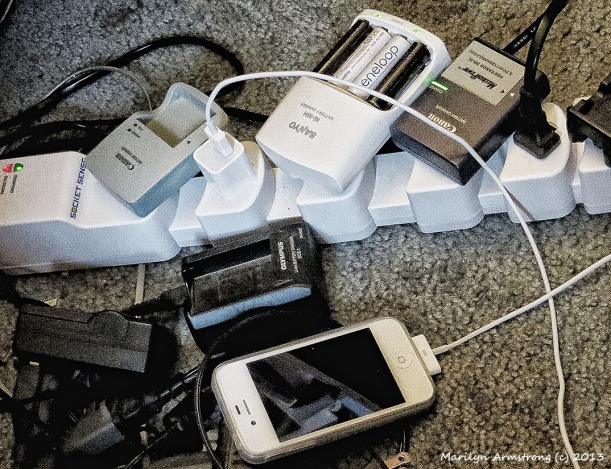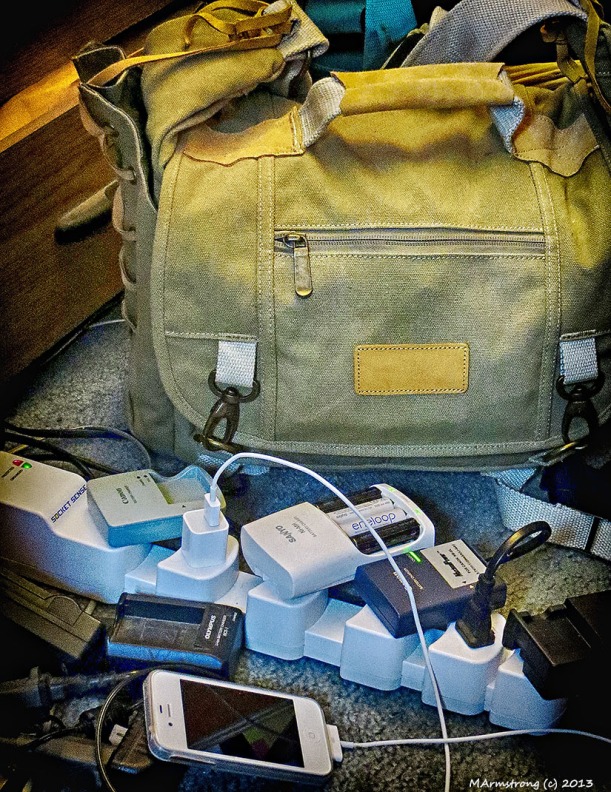My world runs on rechargeable batteries.
Three laptops, two Kindles, two cellphones, six cameras, four mouses (mice have fur and make squeaky noises, mouses attach to your computer), wireless keyboards, GPS, various clocks, flashlights, who-knows-how-many remote controls, electric razors, tooth cleaning machines, and a mind-numbing array of miscellaneous devices I can’t remember off-hand. To keep the world running, Other than those things that run on AAA and AA rechargeable batteries, everything else uses some kind of proprietary battery. I do not understand why camera makers feel obliged to use a different battery for each camera model. Surely they could design at least all cameras of one type to use the same battery.

I don’t always realize how dependent we are on batteries and chargers until I’m packing for vacation. Half a carry-on bag is entirely allocated to chargers and wires. And that’s just for items we use while traveling: laptop accessories, Kindles, cell phones, mouses, portable speakers, cameras and accessories. Laptops and cameras have their own cases … but there’s never enough room for the chargers.

I used to pack all the chargers and wires carefully, all coiled and tied to avoid tangling. One day, I gave up. Now I shove the chargers and wires in a bag and untangle as needed.
At home, I have to keep track of what needs charging and which chargers they use. There are so many I finally was unable to remember which batteries went with which gadget. I really had to address the mess.
The floor of my office is covered with wires and power strips. I’m afraid to walk anywhere because I might step on something fragile.
I did what I do best: research. There are solutions. Not all power strips are the same, and there’s a whole new generation designed to address exactly the problems we all have with too many chargers and power supplies. Some of them are quite pricey, some more affordable. It’s still cheaper to buy a generic strip at Walmart or Target. But you may actually wind up with more usable space if you pay a bit more and get a strip designed to accommodate various sizes and shapes.
–
–
These deal with the problem of oddly shaped and variously sized chargers and power supplies, both strips and as wall sockets.
Let’s start with the Belkin Pivot Surge Protectors. These are available in a 3 versions: a 6-outlet wall mounted version, plus 2 corded versions (6 and 8 foot).
There is extra space between sockets and most also pivot and rotate to let you use all the outlets without waste. Belkin products are usually high quality and they are well-known for their surge protectors. Of course, you may or may not actually need surge protection, but most of these units include it.
I put surge protectors on computers and printers. Battery chargers are cheap and easy to replace and anyway, surges aren’t my problem. Power outages are more likely to be the problem, but a surge protector is no help with that.
Lightning is a problem. Surge protectors are useless against lightning.
We’ve been hit by lightning on three occasions. The first strike was on a utility pole in front of the house. It took out two computers and a printer. The second took down a tree, but no equipment. The third strike killed the well pump which is more than 450 feet underground. That’s how I learned that lightning can strike underground. Apparently the combination of electricity, metal, and water is very attractive to lightning. Well pumps are expensive and not necessarily covered by home insurance.
Lightening is incredibly powerful. Anything plugged in when lightning strikes will get fried. The only thing that will protect against lightning is having your equipment physically unplugged when it strikes. Just a bit of advice from someone who has learned her lesson the hard way.
Insurance will replace equipment, but no one will replace lost data. For that you need a backup on a separate drive.
Prices for the Belkin surge protectors (on Amazon) range from about $18 for the wall-mounted unit, to $25 for the 12-outlet unit with an 8-foot cord, to $27 for the 8-outlet surge protector with a 6-foot cord. The 8-outlet is a very different design and lets you rotate the outlets so that you can use all of the outlets regardless of the size or shape of the chargers or power supplies you want to plug in.
The design of the 8-outlet unit spreads the outlets along a round, wand-like strip that lets you configure the sockets to fit a wide variety of variously sized and shaped chargers and power supplies.
Quite a bit of creativity has gone into some of the designs. By the way, all of these are available on Amazon.
The creative solutions don’t end here. The Kensington 62634 SmartSockets 6-Outlet 16 Foot Cord Table Top Circular Color Coded Power Strip and Surge Protector looks like an electrified lazy Susan. Designed to put in the middle of a conference table so participants can all plug their laptops in at the same time, you could as easily use it on the floor.
It’s rather pricey at more than $40, but it is very cool and if you need a table top strip, this is probably a good choice.
For 25% less, Quirky makes something similar. The white Quirky Pivot Power 6 Outlet Flexible Surge Protector Power Strip costs a couple of dollars less than the identical unit in black. I have no idea why.
Though not cheap, it is not as expensive as the Kensington or Belkin units, nor as fancy. The sockets rotate, but don’t swivel. If you can live without swiveling and color coding, you can get one of these for just under $30. Exactly what will work for you, whether or not any of these will be right for you, depends on the shape of the space you have and how many devices and chargers you have.
If, like me, your charger problem extends into your kitchen and bathroom, there are wall-mounted units for that let you rotate outlets.

360 Electrical 36035-W 4-Outlet Rotating Surge Protector
You can keep your electric razor and water pic plugged in and still have somewhere to attach the hair dryer or curling iron. And if, like my husband, you want to play the radio while you do your daily ablutions, you have a plug for that too. At about $15, it’s a real problem-solver. There are other versions made for kitchen appliances that come with more outlets in some fascinating shapes.
My personal favorite and what consider the most power strip for the least money is Ideative’s Socket Sense 6-Outlet Expandable Surge Protector, 3-Foot Cord. It’s simple and costs just $15. You can set the spacing as needed. Since the equipment in our life keeps changing, I’m attracted by a strip that I can adapt to changing requirements. I have two of them and need one more.
Ideative’s strips are comparatively simple. No rotating or color coding outlets, but you can make the space between outlets larger or smaller, so most things should fit easily. The sockets are angled to make it easier to plug stuff in.
There are more. Tripp Lite makes a series of high voltage surge protecting traditional strips that have as many as 24 outlets.
They are expensive and much higher tech than I need, but it depends on what you need … and the size of your budget, because those babies cost upwards of $50 apiece.
Below is a cord splitter, one alternative to a strip. I have one in my office and it has the advantage that any size device will fit into any plug. These are also sometimes called hubs and may include special sockets for charging USB devices, or hooking up phone lines. I also have a hub like this on my desk that gives me an extra five USB outlets. Just be aware that not every device operates properly through a hub; some devices need to be plugged directly into the computer.
Civilization probably wouldn’t survive the loss of electricity, but until the world as we know it comes to an end, at the very least we can make life a little easier. All you need is willingness to do the research … and a credit card. With some credit on it.
Like so many problems in life, if you throw money at it, you can make it to go away. More or less.
Categories: Cameras, Computers, Technology, Travel







 RECHARGING MY WORLD
RECHARGING MY WORLD
I hate all the cords and wires strung across the floor from one end of the room to another but there is no way seemingly around it in today’s technological world. There is NEVER enough outlets…I don’t care how many one has or how many new ones have been installed…there is just NEVER enough! Of course, that is only half the problem. The other half is the drawer full of chargers that you have no idea what they go to but you hang on to them in hopes of one day finding something that needs charging and the charger is not along with it.
LikeLike
No one in their wildest imaginings ever thought we’d need so many outlets … which I why I have power strips everywhere. Maybe the new ones I bought will help because I can consolidate more chargers onto a single strip. I hope so!
LikeLike
I just had a “Gibbs moment” looking at the pix of all those ‘thing-a-mah-jigs’ charging.
LikeLike
Yeah. We have a few devices. They creep up on you. Mostly, they are in MY office, so you don’t notice them, but they are here and they are taking over.
LikeLike
What an interesting post! I’ve been an electronics technician for 42 years and have never seen some of the power strip devices pictured here. I worked in a textile mill’s instrumentation shop for 13 years. We installed/troubleshot and repaired equipment controlling instruments. South Carolina has more severe thunder & lightning storms than you’ve probably ever seen. The storm used to regularly blow instruments right off the wall, literally. We used what are known as spark gap arrestors to try to save expensive equipment destroyed by lightning strikes more than 10 miles away.
In my experience the safest thing you can do to protect your electronics is buy a special surge protector sold by Radio Shack with a $10,000 guarantee against equipment damage. Now keep in mind that it was years ago that this gadget was sold and it may not be available now. Check their online site at: http://www.radioshack.com/family/index.jsp?categoryId=2820968&sr=1&origkw=surge%20protector
LikeLike
Me neither. I had to search them out online. Also, I think some of these are fairly new on the market. The cord hub/splitter my son bought for me some years ago, probably in Radio Shack. It’s been a life saver. Amazon has everything, but so do other online stores.
LikeLike